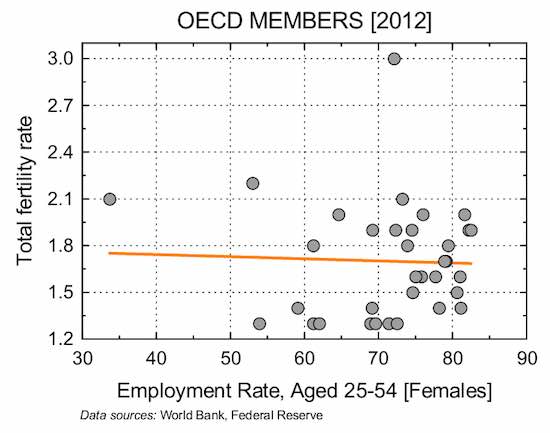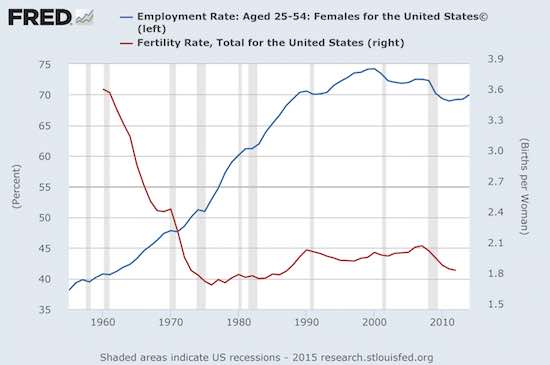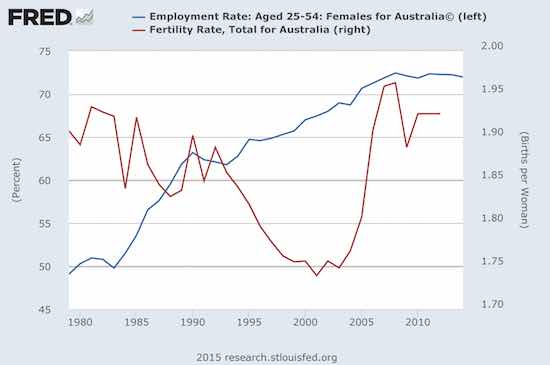By Sierra Rayne ——Bio and Archives--April 8, 2015
American Politics, News | CFP Comments | Reader Friendly | Subscribe | Email Us

 Leaving out Turkey -- the nation with the lowest female employment rate -- doesn't help the case of the anti-family value side. There is still no sign of a significant relationship between the variables.
Of course, looking at snapshots in time between nations is not likely the best way to probe possible causal relationships. Rather, we should be looking at trends over time within countries. And here the evidence is firmly on the side of the family values proponents.
Using the United States as an example, higher female employment rates correlate over time with lower -- not higher -- fertility rates. The relationship isn't perfect, but there is certainly no evidence that higher female employment rates correlate with higher fertility rates (as the Globe and Mail article would lead you to believe). Actually, the correlation heads in the opposite direction.
Leaving out Turkey -- the nation with the lowest female employment rate -- doesn't help the case of the anti-family value side. There is still no sign of a significant relationship between the variables.
Of course, looking at snapshots in time between nations is not likely the best way to probe possible causal relationships. Rather, we should be looking at trends over time within countries. And here the evidence is firmly on the side of the family values proponents.
Using the United States as an example, higher female employment rates correlate over time with lower -- not higher -- fertility rates. The relationship isn't perfect, but there is certainly no evidence that higher female employment rates correlate with higher fertility rates (as the Globe and Mail article would lead you to believe). Actually, the correlation heads in the opposite direction.
 The same time series patterns between the two variables -- once again, increasing female employment rates correlate with declining, not increasing, fertility rates -- are evident in other nations with long-term datasets.
Conservatism is also blamed for lower fertility rates:
The same time series patterns between the two variables -- once again, increasing female employment rates correlate with declining, not increasing, fertility rates -- are evident in other nations with long-term datasets.
Conservatism is also blamed for lower fertility rates:
[T]he traditional family is the enemy of the successful family. This was confirmed in another recent study, by Australian scholars Peter McDonald and Helen Moyle, which notes that the European countries with "very low fertility" are generally "conservative" countries that "hold more to the 'breadwinner' model of the family," whereas those countries with "sustainable fertility" rates are all "social-democratic countries [which] seek higher levels of gender equity within the family and the workplace."Just looking at Canada and the United States casts doubt on the generality of this hypothesis across developed nations. The USA is clearly a far more inherently conservative nation than Canada, and it also has a higher fertility rate (1.88) than Canada (1.61). Both Canada and (especially) the USA are more conservative than Europe, and yet the EU has a lower fertility rate (1.57) than either of its North American counterparts. Furthermore, no developed European nations other than Turkey (an effective Islamic state) have truly "sustainable" fertility rates, which are TFRs of at least 2.1. The "gender equity" issue starts to get to the heart of how we should be looking at the data. When the difference between the male and female employment rates among 25-54 year olds is plotted against the fertility rate, we find a positive -- not negative -- correlation. In other words, increasing gender inequality in employment rates (the male employment rates are all higher than their female counterparts) correlates with higher fertility rates among all OECD nations. Finally we arrive at the problematic applications of these questionable policy analyses:
The Australian study looked at fertility in English-speaking countries and found that some of those countries -- notably Britain and Australia -- had introduced policies in the late 1990s and early 2000s to encourage women to enter the work force (by subsidizing childcare, requiring flexible work schedules and offering maternity leave). In those countries, such policies marked the beginning of a big rise in fertility and family sizes over the past decade and a half. Canada, they noted, remains an outlier: Its fertility has been stuck at a middling 1.7 children per family for a long time -- in part because immigration keeps the working-age population from collapsing, but also because Canada has not followed its Commonwealth neighbours in introducing national child-care strategies and other such programs designed to increase the participation of women in the work force. Now that we know those policies will produce a lot more tiny Canadians -- something we could really use -- we have two very good reasons to start making them a reality.It is true that Canada's fertility rate has been "stuck" at around 1.6 for several decades, but the employment rate for 25-54 year old females has skyrocketed since OECD records for this nation began in 1995 -- increasing from 69 to 78 percent.
 By comparison, the female employment rate for this age group in the UK only increased by 3 percent (from 73 to 76 percent) "over the past decade and a half" while its fertility rate increased from 1.64 to 1.90. Thus, Canada's female employment rate increased three times faster than the UK's, but Canada's fertility rate did not increase while the UK's did. The trends in the data are the exact opposite one would expect based on the conclusions of the Globe and Mail article.
As for Australia, it did see a rapid increase in its fertility rate between 2003 and 2007 -- and a subsequent plateau at about the same levels last seen in the late 1980s and early 1990s, but when considered within a historical context alongside female employment rates, it is clear there was no increase in female employment to explain this short term trend.
By comparison, the female employment rate for this age group in the UK only increased by 3 percent (from 73 to 76 percent) "over the past decade and a half" while its fertility rate increased from 1.64 to 1.90. Thus, Canada's female employment rate increased three times faster than the UK's, but Canada's fertility rate did not increase while the UK's did. The trends in the data are the exact opposite one would expect based on the conclusions of the Globe and Mail article.
As for Australia, it did see a rapid increase in its fertility rate between 2003 and 2007 -- and a subsequent plateau at about the same levels last seen in the late 1980s and early 1990s, but when considered within a historical context alongside female employment rates, it is clear there was no increase in female employment to explain this short term trend.
 Female employment rates down under were not changing over this period at a pace any different than they had been since the early 1990s, and at a far lower rate than during the 1980s. The female employment rate in Australia increased just 3 percent (from 69 to 72 percent) during the 2003-2007 fertility rate increase. This is, as with the UK, a female employment rate increase three-fold smaller than Canada experienced since the mid-1990s -- and yet Canada's fertility rate remained unchanged.
Canada's female employment rate is also currently higher than that in the UK or Australia. If we accepted the anti-family values policy conclusions, Canada's fertility rate should have increased far more than Australia's or the United Kingdom's over the last decade or two -- and it should be higher than in either of these countries. But it did not, and it is not.
Consequently, there looks to be no clear evidence that throwing "family values" out the window will lead to a general fertility rate increase among developed nations.
Female employment rates down under were not changing over this period at a pace any different than they had been since the early 1990s, and at a far lower rate than during the 1980s. The female employment rate in Australia increased just 3 percent (from 69 to 72 percent) during the 2003-2007 fertility rate increase. This is, as with the UK, a female employment rate increase three-fold smaller than Canada experienced since the mid-1990s -- and yet Canada's fertility rate remained unchanged.
Canada's female employment rate is also currently higher than that in the UK or Australia. If we accepted the anti-family values policy conclusions, Canada's fertility rate should have increased far more than Australia's or the United Kingdom's over the last decade or two -- and it should be higher than in either of these countries. But it did not, and it is not.
Consequently, there looks to be no clear evidence that throwing "family values" out the window will lead to a general fertility rate increase among developed nations.View Comments
Sierra Rayne holds a Ph.D. in Chemistry and writes regularly on environment, energy, and national security topics. He can be found on Twitter at @srayne_ca